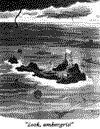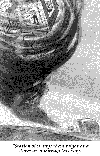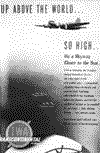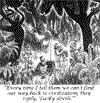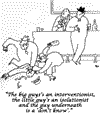









War Fears
(CLICK ON THUMBNAIL FOR VIEWABLE IMAGE)
Some images can be expanded further by clicking in the lower right corner of the full sized version.
Some images can be expanded further by clicking in the lower right corner of the full sized version.
When I first saw this cartoon twenty plus years ago I thought it evoked the essence of
Iva Toguri’s life story.
The cartoon summed up the situation of Americans in 1941: an isolated island,
surrounded by danger from sharks and mines, sea tornadoes on the way. The joke is
that one sailor is overjoyed that he has found ambergris – at the time an expensive
and irreplaceable ingredient of perfume – even though it has no value in his present
situation.
How exactly would the American public have read the subtext of this cartoon just a few months before Pearl Harbor? Would they have seen themselves as people living in a fool’s paradise like the delighted sailor, oblivious to the fact that he is isolated and marooned, and that his good fortune is in fact worthless. Or would they have seen themselves in him because they too possessed something of great value, the safety of an island in a sea of danger. Perhaps they would have identified with the other sailor, sitting beneath a white flag that symbolized a surrender to his fate, watching the unfolding scene with bitter amusement and arms defiantly crossed.
The cartoon made me think of Iva because she too was trapped on an island, surrounded by inescapable forces, and eventually the storm hit her full force. Yet through this experience she found something infinitely precious, which in her case was not economically valuable but spiritually. Iva found her own true self, devel- oped her good character, proved her integrity, and became who she ought to be.
How exactly would the American public have read the subtext of this cartoon just a few months before Pearl Harbor? Would they have seen themselves as people living in a fool’s paradise like the delighted sailor, oblivious to the fact that he is isolated and marooned, and that his good fortune is in fact worthless. Or would they have seen themselves in him because they too possessed something of great value, the safety of an island in a sea of danger. Perhaps they would have identified with the other sailor, sitting beneath a white flag that symbolized a surrender to his fate, watching the unfolding scene with bitter amusement and arms defiantly crossed.
The cartoon made me think of Iva because she too was trapped on an island, surrounded by inescapable forces, and eventually the storm hit her full force. Yet through this experience she found something infinitely precious, which in her case was not economically valuable but spiritually. Iva found her own true self, devel- oped her good character, proved her integrity, and became who she ought to be.
It should come as no surprise that cartoons of the time often featured tornadoes,
symbols of monstrous forces before which ordinary human beings are helpless:
No wonder TWA ran advertisements that promised travelers they would be “Up Above
the World So High.” The Boeing Stratoliner’s skyway promised to be “closer to the
sun” than to the Earth and its storms—presumably a pleasing prospect for
passengers weighed down with worldly concerns.
Like those “up above the world,” people lost in jungles or marooned on islands also
escaped a world at war.
Others not so lucky had to escape as best they could:
It seemed every man and beast had to choose sides:
Civilization itself was at stake:
Things were so bad that gorillas now lived in Europe. Note that the head gorilla was
abnormally square and stout. Was he a caricature of Goering? Mussolini? Stalin?
abnormally square and stout. Was he a caricature of Goering? Mussolini? Stalin?
This masterpiece exemplified the fear of the loss of civilization. The drawing served as
space filler and was irrelevant to the material around it. It had no caption.
“The chemist” above expressed thoughts hidden beneath the everyday conscious-
ness of Americans. If one pays attention, such expressions were common. Take this
spoof of an angry wife:
The obvious joke is that the woman confuses “going down in history” with “going
somewhere.” (Cartoons in 1940 often portrayed mentally dense women.)
But is there more here than the cartoonist consciously intended? Was there a concern that history was being made around the world while we Americans sat at home puttering over sheet music, not going anywhere? Was there perhaps an indirect acknowledgment that the fact of war meant that men, not women—the words are underlined in the original—would be going down in history because they were actually going somewhere: namely, off to fight.
Remember the previous “everything is upside down” cartoon. In that cartoon, Americans would most identify with the sloth, a notorious symbol of laziness. Viewing the kangaroo cartoon below, Americans would have identified with the joey, which means the cartoonist represented them as being childish.
But is there more here than the cartoonist consciously intended? Was there a concern that history was being made around the world while we Americans sat at home puttering over sheet music, not going anywhere? Was there perhaps an indirect acknowledgment that the fact of war meant that men, not women—the words are underlined in the original—would be going down in history because they were actually going somewhere: namely, off to fight.
Remember the previous “everything is upside down” cartoon. In that cartoon, Americans would most identify with the sloth, a notorious symbol of laziness. Viewing the kangaroo cartoon below, Americans would have identified with the joey, which means the cartoonist represented them as being childish.
The origins of the phrases “my two cents worth” (meaning “my
opinion”) and “I wouldn’t give two cents for it” (meaning “it’s
worthless to me”) are unclear, but this fellow caught the spirit of how
Americans viewed what was happening in the rest of the world.
The incessant conquest of other countries confused even school
children:
This uncaptioned little gem summed up the attitude of many Americans in 1940-41.
Who was this chemist? His sweater would indicate a college student. Did he represent
student athletes who looked out of place in the classroom? He seems much too old for
that. Was the drawing an indirect indictment of Germany’s Third Reich: brute strength
seeking even more power through science? He hardly appears the Aryan ideal,
although Americans might have imagined him mixing new and more potent versions
of poison gas, which they remembered from World War I.
I suspect the letter “P” stands for pithecanthropus, which in 1941 was a generic name for the primitive ancestors of humans. The drawing suggests that humans were evolving backwards, and that “ape-men,” to use another popular term of the time, busied themselves mastering science in universities. If I am correct, it means this drawing also manifests the theme of several previous cartoons that the world situation in 1940-41 showed humanity reverting to the bestial.
I suspect the letter “P” stands for pithecanthropus, which in 1941 was a generic name for the primitive ancestors of humans. The drawing suggests that humans were evolving backwards, and that “ape-men,” to use another popular term of the time, busied themselves mastering science in universities. If I am correct, it means this drawing also manifests the theme of several previous cartoons that the world situation in 1940-41 showed humanity reverting to the bestial.
Tokyo Rose /
An American Patriot:
A Dual Biography
An American Patriot:
A Dual Biography
